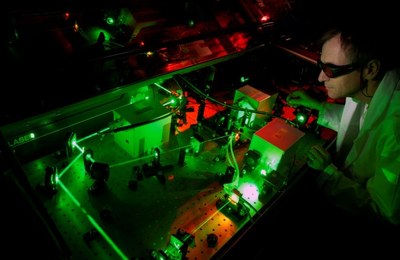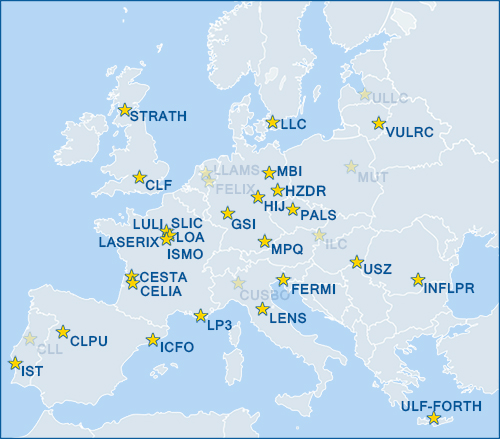ILAT- Innovative Laser Technologies
 |
|---|
| Laser alignment in one of LASERLAB-EUROPE’s laser research labs |
For this JRA five objectives for the development of future advanced radiation sources are identified:
Objective 1: Increasing power and pulse energy of the primary laser sources requires well developed optical materials with precisely known parameters and sophisticated well simulated cooling schemes. Maintaining the beam pointing stability of high peak powers as the repetition rate increases is a bottleneck to be solved if such lasers are to be used for the projected applications. These development tasks will be in the province of this work package and will be tackled by advanced simulations, laser material development and investigation of important laser relevant parameters like damage thresholds and nonlinear optical coefficient measurements.
Objective 2: Many of the so called secondary sources including especially high energy particle sources require ultra-short pump pulses that need to be improved in terms of their peak contrast as well as, a parameter only relevant for such pulses, the carrier envelope phase (CEP). Additionally, identifying methods to improve the intensity in the focal spot is also critical in ultra-short laser pulse systems. These problems will addressed by several alternative methods with a high application potential in the increasing number of large scale laser facilities around the world, with Europe playing a world-leading role in this field.
Objective 3: Next generation coherent X-ray sources demand for high peak power, high pulse energy, high repetition rate and improved pulse characteristics. In this contest novel operating schemes for Free Electron Lasers (FELs) and coherent high-order harmonic amplification in laser produced plasmas will be investigated both experimentally and theoretically.
Objective 4: Scaling up energy in the mid-IR combined with high repetition rate is another challenging goal. Mid-IR sources cover the important fingerprint region for biologically relevant molecules and therefore offer new possibilities for spectroscopy and biomedical applications. The main technology used for these sources is optical parametric and optical parametric chirped pulse amplification (OPA, OPCPA) driven by near infrared high power lasers as developed within Objective 1. These nonlinear processes together with new materials are studied in detail supported by numerical simulations.
Objective 5: Applications of high energy THz sources require THz field strengths which are one or two orders of magnitude larger than what is presently available. The various parts of the THz spectrum can be reached with sources based on different technologies like optical rectification, difference-frequency generation and plasma-based THz sources, approaches that will be pushed beyond todays’ power limits in this JRA. The requirement of the pump sources also vary through the spectrum. Diode-pumped solid-state lasers (DPSSL) suitable to drive highest-intensity THz sources needs to be developed.
Coordinator: Joachim Hein
Participants:
 |
|
Subcontractor
CIMAP institute, Caen, France
Univ. Nova Gorica, Slovenia
Industrial Partners
Hellma Materials GmbH (SME), Layertec GmbH (SME), Lastronics GmbH (SME), Horiba Jobin-Yvon, FastLite (SME), SourceLAB (SME)

